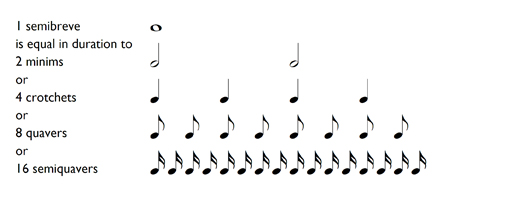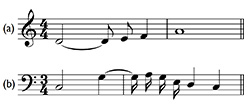3.5 Dots and ties
In Section 3.1, Example 14 we outlined the time values of each type of note. Here is a reminder of those note values:
Example 14 (repeated)

However, a time value of each type of note can be lengthened (and therefore changed) through the use of:
- a dot or
- a tie.
A dot after any value extends that value by half as much again. Therefore a dotted crotchet lasts for a crotchet plus a half a crotchet (i.e. a quaver). In other words, as shown in Example 18, it lasts for the duration of three quavers in total.
Example 18
The dot is placed to the right of the note head, in the same space if the note head is in a space, or above the line if a note head is on a line. Example 19 summarises these principles.
Example 19

As you learned in Section 3.3, bar lines mark off groups of beats according to the time signature. In 4/4 time, therefore, there cannot be any more than four beats per bar. If we want to extend a time value where the lengthened value crosses a bar line, a tie can be used, as shown in Example 20. In this particular example, the effect of the tie is the same as if we had used a dot: the value of the minim is increased by a half (because it is joined to a crotchet which is half the value of a minim).
Example 20

However, as shown in Example 21, a tie can also be used to increase a value by a different fraction. So as Example 21 (a) shows, a minim can be tied to a quaver, the quaver being a quarter of the minim’s value; and as shown in Example 21 (b), a crotchet can be tied to a semiquaver, the semiquaver being a quarter of the crotchet’s value. Either can take place within a bar or across a bar line.
Example 21

You can tie any number of adjacent notes together in this way – but the tied notes must always have the same pitch. The ties must also be placed on the ‘outside’ of the note heads as you can see in Example 21.
